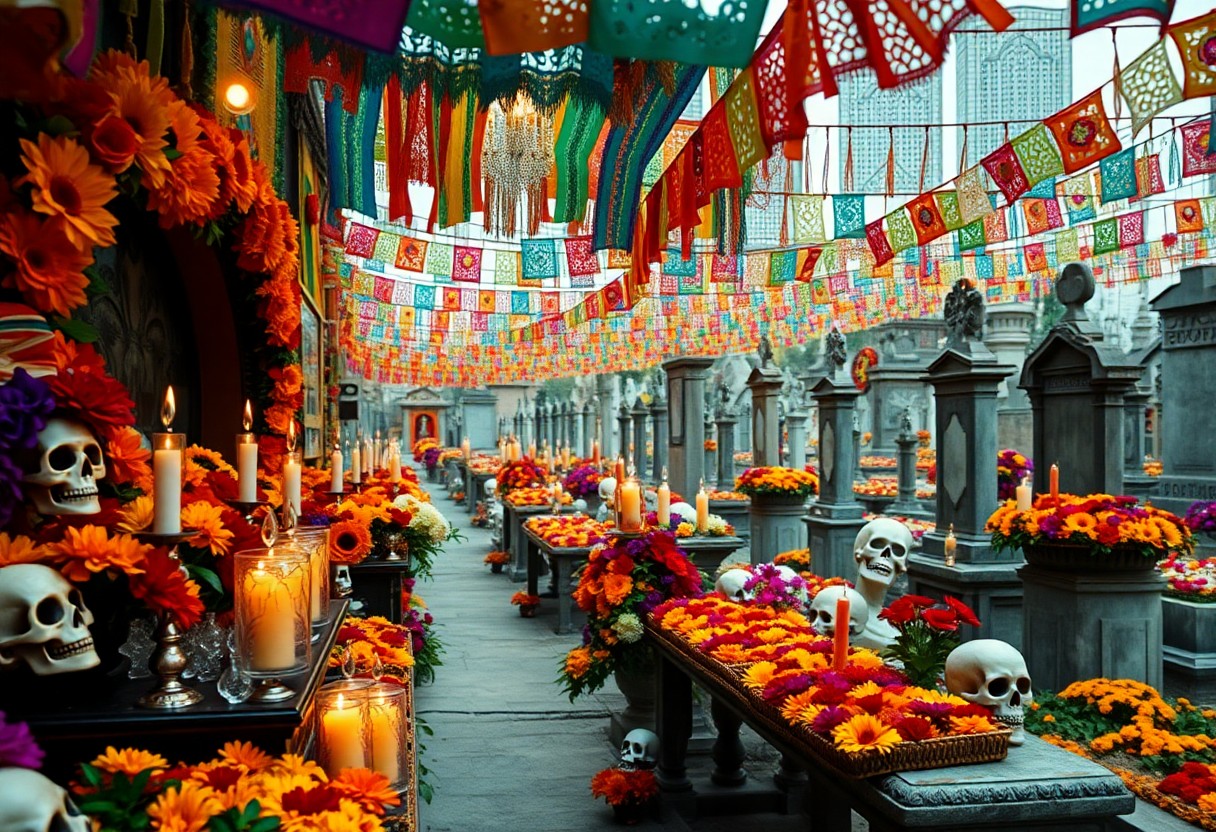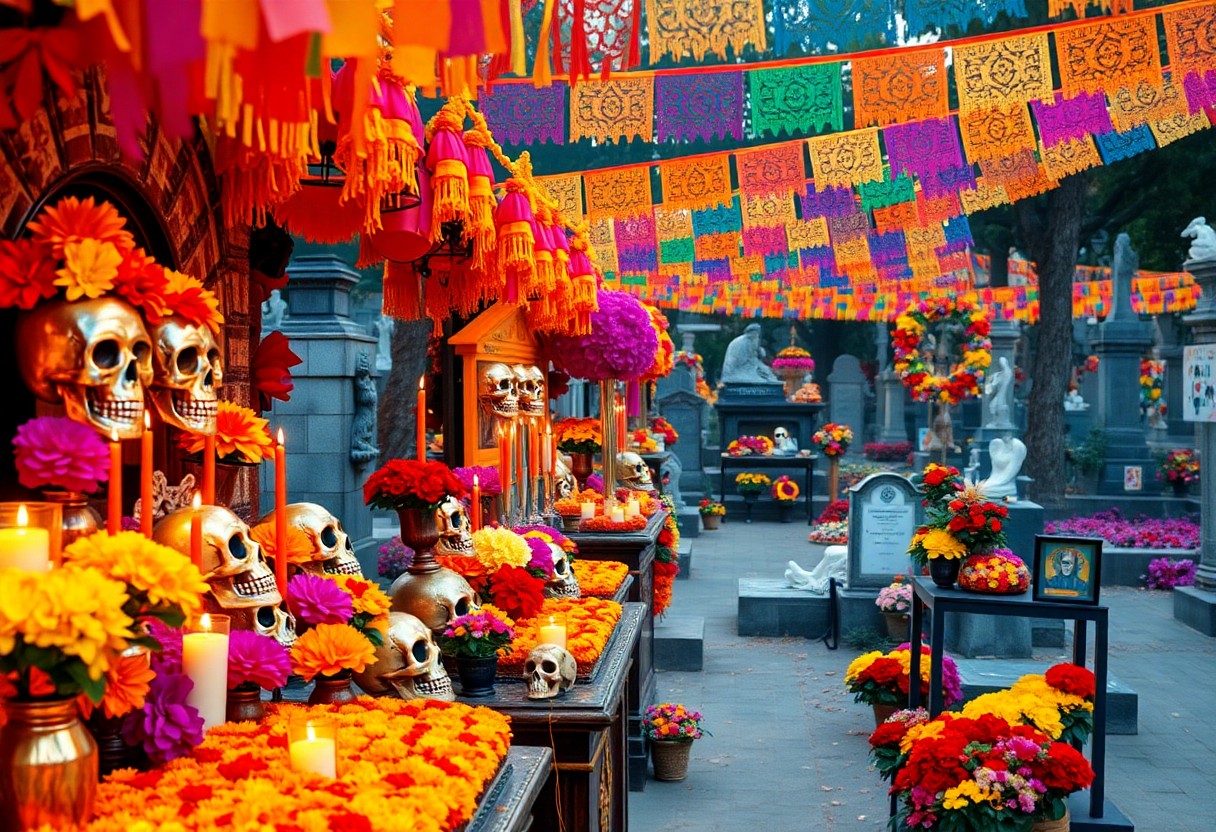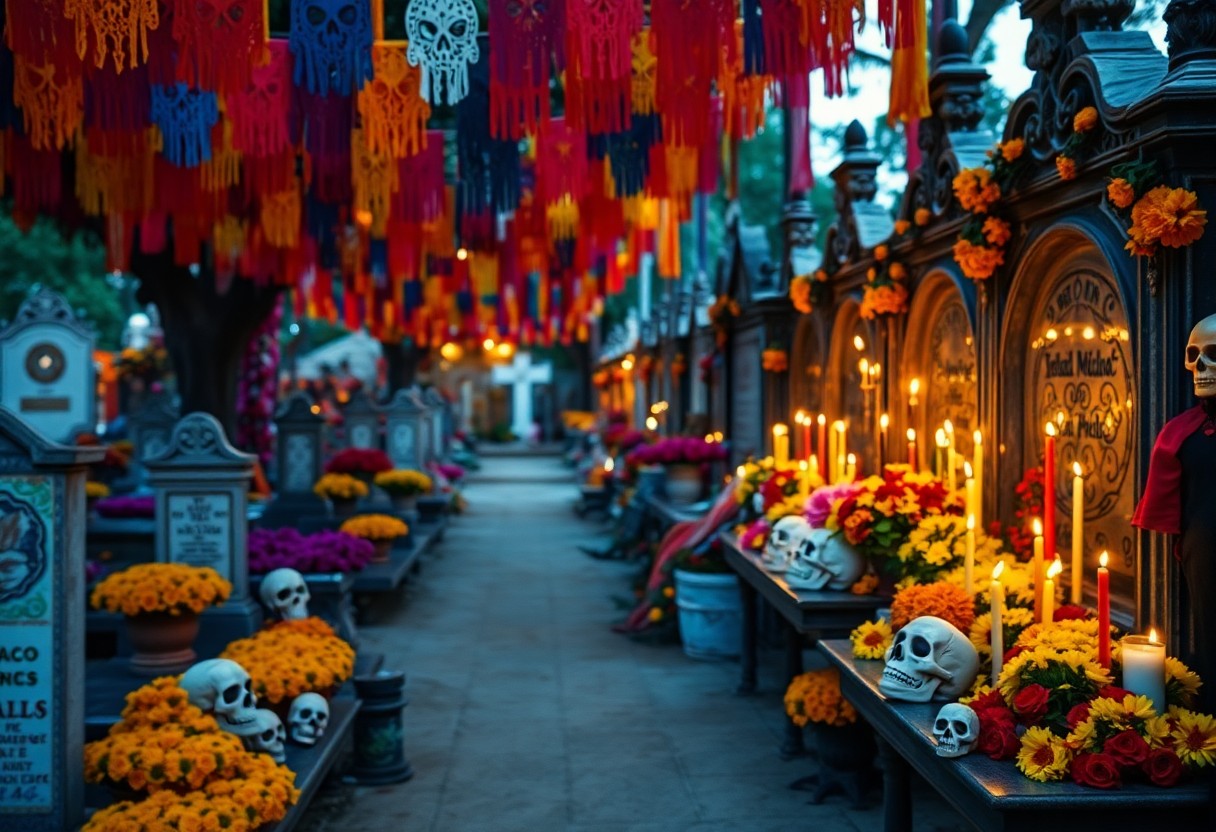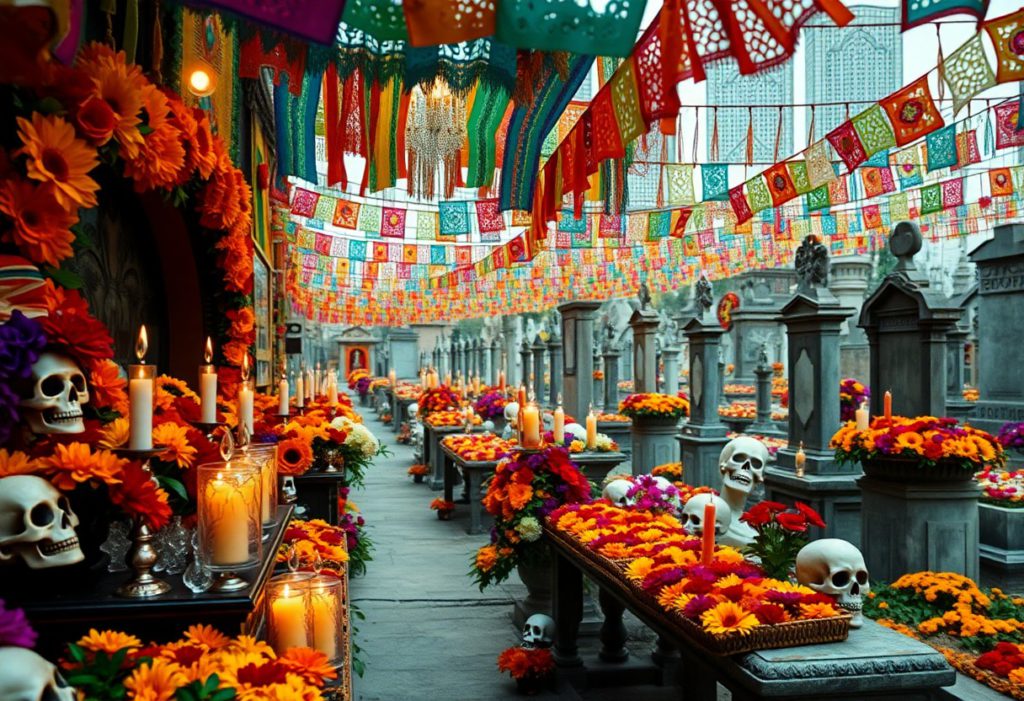In various cultures, the subject of death is often viewed as a taboo topic; however, in San Miguel de Allende, the approach is refreshingly different. Here, death is celebrated in a vibrant and colorful way, particularly during the Day of the Dead. This festive occasion transforms the streets into a tapestry of marigolds, where families unite to honor their departed loved ones, and elaborate altars are filled with meaningful offerings. Rather than being a time of sorrow, this celebration embraces death as a natural part of the life cycle. In San Miguel de Allende, you can experience a mesmerizing blend of ancient rituals and modern celebrations, making it a must-visit destination to witness this rich cultural tradition that highlights both life and remembrance.

Discover the Rich Historical Roots of the Day of the Dead Tradition
Long before the arrival of Spanish colonizers, the Day of the Dead (Día de los Muertos) found its roots in ancient Mesoamerican cultures, particularly among the indigenous peoples such as the Aztecs. They celebrated a month-long festival in honor of the goddess Mictecacihuatl during the Aztec month of Miccailhuitontli. This ancient observance was a profound tribute to the cyclical nature of existence, intertwining life and death in a respectful manner. Today, the enduring reverence for ancestors and the seamless continuity of life remains a fundamental aspect of this culturally rich observance, echoing through generations and resonating with individuals worldwide.
Engage with Timeless Ancient Traditions and Rituals
For over 2,500 years, various indigenous civilizations in Mexico have participated in sacred rituals honoring their deceased ancestors. These time-honored traditions involve offerings of food, vibrant flowers, and aromatic incense—each symbolizing the lasting connection between the living and the departed. The Aztecs held a belief that death represented not an end but a transition into another realm of existence, a perspective that significantly influences the essence of the Day of the Dead today. This celebration emphasizes the joy of life alongside the memory of those who have passed, fostering a profound sense of community and remembrance among families.
Explore the Impact of Spanish Colonization on Day of the Dead Celebrations
The arrival of Spanish colonizers in the 16th century brought significant changes to the Day of the Dead festivities. The Catholic Church integrated indigenous customs with the observances of All Saints' Day (November 1st) and All Souls' Day (November 2nd), condensing what was once a month-long festival into a two-day celebration. This fascinating cultural amalgamation gave rise to the modern iteration of the holiday, artfully blending pre-Hispanic traditions with Catholic practices to create a unique cultural tapestry that honors both heritage and faith. The introduction of new elements, such as the vibrant incorporation of marigold flowers and ofrendas (altars), has become integral to the celebration.
Despite the Spanish attempts to diminish indigenous customs, the resilience and vibrancy of these traditions have thrived, resulting in a rich cultural fusion. Today, the Day of the Dead in San Miguel de Allende reflects this illustrious history, offering a vibrant and meaningful experience for both locals and visitors, allowing them to connect with the past while celebrating the present.
Understand the Deep Significance of the Day of the Dead Celebration
One of the most profound elements of the Day of the Dead is its focus on celebrating life instead of mourning death. In San Miguel de Allende, this remarkable tradition transforms grief into joy, as families create vibrant altars, share lively music, and offer heartfelt tributes to their departed loved ones. The belief that the spirits of the deceased return to partake in the celebrations fosters a spiritual reunion that is both uplifting and deeply meaningful. This distinctive perspective on death, rooted in ancient Mesoamerican and Catholic traditions, transforms the Day of the Dead into an emotionally rich and reverent experience that resonates with all participants.
Recognize the Importance of Ofrendas in Day of the Dead Celebrations
Ofrendas, or altars, stand at the heart of the Day of the Dead festivities in San Miguel de Allende. These elaborately designed altars are beautifully adorned with vibrant marigold flowers, flickering candles, treasured photographs, and the favorite dishes and beverages of the deceased. Serving as a welcoming space for the spirits, the ofrendas embody love, remembrance, and connection with those who have passed. By creating these altars, families ensure that the memories of their loved ones endure, melding tradition with personal sentiment and heartfelt expressions that resonate deeply within the community.
Trace the Evolution of Day of the Dead Celebrations in Contemporary Culture
As time progresses, the Day of the Dead in San Miguel de Allende has gracefully adapted to modern influences while remaining rooted in its cultural heritage. While some urban areas may incorporate elements reminiscent of Halloween, the core essence of honoring the departed remains steadfast. This celebration has gained popularity, attracting visitors from around the globe who seek to immerse themselves in its unique blend of tradition, culture, and festivity, making it an unforgettable event for everyone involved.
The forces of globalization have drawn increased international attention to the Day of the Dead, leading to a fascinating interplay of cultural influences. In San Miguel de Allende, this has created both opportunities and challenges. While the rising popularity of the festival has significantly bolstered tourism, there are ongoing concerns about preserving the authenticity of the celebration. Nevertheless, the community remains committed to upholding the sacred and joyful spirit of the event, ensuring it continues to honor the deceased with profound respect and reverence.

Gain Insight into Mexico’s Distinct Perspective on Death and Remembrance
Mexico’s relationship with death is notably different from many other cultures around the world. Here, death is perceived not as an end but as a natural progression of life, a viewpoint deeply rooted in indigenous traditions intertwined with Catholic beliefs. During the Day of the Dead, this outlook is celebrated with vibrant colors, lively music, and joyous remembrance, transforming what may be a somber occasion elsewhere into a colorful tribute to life. In San Miguel de Allende, this celebration is particularly vivid, characterized by ofrendas (altars) adorned with marigolds, photographs, and offerings that invite the spirits of loved ones back home. Here, death is embraced with open arms rather than feared, creating a unique cultural experience that is both enriching and enlightening.

Distinguish Between the Day of the Dead and Halloween: Two Unique Celebrations
While both the Day of the Dead and Halloween share themes of death and skeletons, their meanings and approaches are fundamentally distinct. The Day of the Dead, or Día de los Muertos, is a celebratory observance centered around honoring deceased loved ones, with deep roots in Mexican culture. In contrast, Halloween is primarily a festival of spooky fun with Celtic origins, focusing on fear and mystery. While Halloween emphasizes eerie themes, the Day of the Dead celebrates the remembrance and commemoration of life, offering a richer emotional experience that fosters connection and reflection.
Investigate the Historical Roots of Both Celebrations
The Day of the Dead traces its origins over 3,000 years back to ancient Mesoamerican civilizations, particularly the Aztecs, who honored the goddess Mictecacihuatl in their rituals. When Spanish colonization occurred, this tradition intermingled with Catholic holidays, namely All Saints’ Day and All Souls’ Day, leading to the modern celebration recognized today. Conversely, Halloween originated from the Celtic festival of Samhain, which marked the thin line between the living and the dead, eventually being adapted into Christian practices.
Delve into the Meaning and Purpose of Each Celebration
The Day of the Dead serves as a time to celebrate the lives of those who have passed away, embracing the reality of death as an integral part of life’s journey. Families create ofrendas (altars) adorned with marigolds, photographs, and favorite dishes to welcome the spirits back into their homes. In contrast, Halloween is characterized by fun and fright, featuring costumes, trick-or-treating, and spooky themes that prioritize entertainment over reflection.
Furthermore, the Day of the Dead carries a deeply spiritual essence, emphasizing the reconnection with ancestors and honoring their legacy. It provides an opportunity for families to come together, share stories, and celebrate the continuity of life. In comparison, while Halloween offers entertainment, it lacks the profound cultural and emotional depth that the Day of the Dead embodies, making the latter a truly unique experience.
Examine the Distinct Traditions and Activities of Both Celebrations
In San Miguel de Allende, the vibrant customs of the Day of the Dead come to life through ofrendas, lively parades, and families decorating graves with marigolds. Participants often dress as Catrinas or skeletons, while traditional foods like <a href=”https://fallinginlovewithsanmiguel.com/top-5-reasons-to-retire-in-san-miguel/”>pan de muerto</a> are shared among friends and family. In contrast, Halloween festivities typically include trick-or-treating, pumpkin carving, and costume parties influenced by American culture.
While Halloween celebrations in San Miguel de Allende are more common among expatriates and urban locals, the Day of the Dead remains a deeply rooted tradition for many Mexican families. The city’s celebrations beautifully blend solemn remembrance with vibrant festivities, offering a unique and rich experience that cannot be found elsewhere, making it a cherished time for both locals and visitors alike.
Experience the Lively and Colorful Day of the Dead Festival in San Miguel de Allende
Despite its colonial charm, San Miguel de Allende transforms into a bustling center of activity during the Day of the Dead. Visitors will be treated to streets brimming with vibrant marigold flowers, intricate papel picado, and families gathering to honor their loved ones. The city hosts lively parades, where locals don costumes as Catrinas and skeletons, seamlessly merging tradition with artistic expression. You can explore beautifully crafted ofrendas in public spaces, each telling a poignant story of remembrance. While the celebration is filled with joy, it is crucial to respect the sacred nature of the occasion, especially in cemeteries where families come together privately to commemorate the lives of those who have departed.
Unraveling the Rich and Traditional Customs of the Day of the Dead
For centuries, the Day of the Dead traditions in San Miguel de Allende have harmoniously intertwined indigenous and Catholic influences, resulting in a vibrant celebration that honors both life and death. Families construct ofrendas (altars) adorned with photographs, candles, and favorite foods of the deceased. The streets come alive with marigolds, calaveras (decorated skulls), and papel picado (perforated paper banners). These cherished customs serve as a powerful tribute to loved ones, inviting their spirits to return and celebrate alongside the living. The atmosphere is filled with joy, music, parades, and communal gatherings that reflect the Mexican embrace of death as an integral part of life’s journey.
Recognizing the Significance of Alfeñiques and Papel Picado in the Festivities
Integral to the Day of the Dead celebrations, alfeñiques are intricate sugar sculptures crafted in the shape of skulls, animals, or other figures. These delightful works of art symbolize the sweetness of life and are often personalized with the names of the deceased. Complementing these edible creations, papel picado—delicately cut tissue paper banners—add vivid color and movement to the celebrations. The perforations in the paper are thought to guide spirits to the ofrendas, while the vibrant designs serve as poignant reminders of life’s fleeting nature and the joy found in remembrance.
Explore the Cultural Significance of Marigolds and Calaveras During the Celebration
If you visit San Miguel de Allende during the Day of the Dead, you'll find yourself enveloped by the striking orange hues of marigolds, known as cempasúchil. These flowers are believed to guide spirits with their vivid colors and fragrant aroma, creating a welcoming path for the departed. Alongside them, calaveras (decorated skulls) are omnipresent—adorning altars, appearing in parades, and even serving as face paint. These whimsical and colorful skulls embody the playful acceptance of death that is prevalent in Mexican culture, emphasizing the belief that death is not something to be feared but embraced.
A deeper examination of marigolds and calaveras reveals their significant cultural meaning. Marigolds are not merely decorative; their petals craft paths leading to ofrendas, ensuring that spirits can find their way home. Calaveras, whether crafted from sugar, clay, or painted on faces, serve as reminders that death is a part of life’s journey worthy of celebration. In San Miguel de Allende, these elements coalesce to create a visually stunning and spiritually enriching experience, honoring the cycle of life and death in a manner that is simultaneously joyful and respectful.
Embrace Life, Memory, and Celebration in San Miguel de Allende
Experiencing San Miguel de Allende during the Day of the Dead offers a profound opportunity to embrace death through its vibrant celebrations. You will witness a captivating blend of ancient traditions and contemporary expressions, where families honor their loved ones with colorful altars, marigold flowers, and joyous gatherings. The city’s streets come alive with parades, papel picado, and the enticing aroma of pan de muerto, inviting you to immerse yourself in a cultural perspective that views death as a natural part of life. In San Miguel de Allende, you don’t just observe the Day of the Dead—you embody its spirit, celebrating life and memory in an authentically Mexican manner.
Your Guide to Frequently Asked Questions About the Day of the Dead Celebration
Q: What makes San Miguel de Allende a standout destination for celebrating the Day of the Dead?
A: San Miguel de Allende is celebrated for its vibrant and authentic Day of the Dead festivities. The city expertly weaves traditional Mexican customs with local nuances, resulting in elaborate parades, colorful altars, and heartfelt community gatherings. The historic streets and colonial architecture provide a picturesque backdrop for the festivities, creating a memorable experience for all visitors.
Q: What are the key traditions associated with the Day of the Dead in San Miguel de Allende?
A: Essential traditions involve crafting ofrendas (altars) adorned with stunning marigold flowers, cherished photographs of the deceased, and their favorite foods. Families engage in cleaning and decorating graves, and many participants dress as skeletons or Catrinas. The city also hosts vibrant parades, live music, and cultural performances, offering a unique blend of solemn remembrance and joyful celebration that captivates all who attend.
Q: How can visitors respectfully participate in Day of the Dead celebrations in San Miguel de Allende?
A: Visitors should engage with the celebrations in a respectful and culturally sensitive manner. It's advisable to avoid intrusive photography in cemeteries, as these spaces hold deep significance for families. Participating in public events like parades and workshops is encouraged, along with gaining a deeper understanding of the traditions beforehand. Supporting local artisans by purchasing handmade crafts or traditional foods is also a meaningful way to connect with the culture and show appreciation for its rich heritage.
The Article: Day of the Dead: A Unique Way to Embrace Death in San Miguel de Allende appeared first on https://fallinginlovewithsanmiguel.com/
The Article Embrace Death: Discover Day of the Dead in San Miguel de Allende Was Found On https://limitsofstrategy.com
The Article Day of the Dead in San Miguel de Allende: Embrace Death First Appeared ON
: https://ad4sc.com



Your description of the Day of the Dead in San Miguel de Allende truly captures the essence of how cultures can transform our perception of death. It’s fascinating to see how this celebration fosters a sense of community and continuity, allowing families to share stories of their loved ones and keep memories alive. This contrasts sharply with the often somber view of death in many other cultures.
You’ve hit on something really important about the Day of the Dead. It’s not just a celebration; it’s a way to weave the past into everyday life. In San Miguel de Allende, the vibrant altars and the shared laughter as families recount memories create a special connection. It reminds us that death doesn’t have to be the end of storytelling; rather, it’s a bridge to deeper conversations about love and loss.
Thank you for your insightful comment! If you’d like to explore more about the vibrant traditions and community spirit during the Day of the Dead, check out this link for a deeper dive into the celebration.
https://notpotatoes.com/quillbot
I love the way you highlight the vibrant approach to death in San Miguel de Allende! It truly is fascinating how different cultures navigate the conversation around death. In many places, it’s often shrouded in fear or sadness, yet during Día de los Muertos, it’s almost a joyous reunion with memories. I’ve always been intrigued by how these celebrations can foster a deeper connection among families and communities, creating space for both remembrance and joy. Have you seen how altars in different regions vary? Some places use photos and favorite foods of the departed, while others incorporate unique local traditions. It makes me wonder how these practices can also influence our views on life and health. Wouldn’t it be enriching to embrace such open conversations about death more broadly?